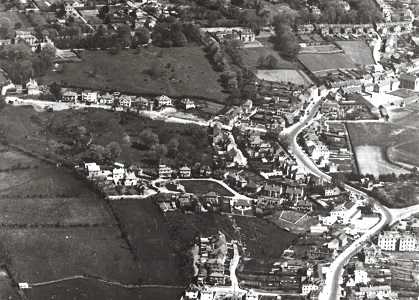Old Galway
WHEN THE HANGMAN CAME TO GALWAY

by Tom Kenny
In 1883, Thomas Parry, a 26 year old assistant shepherd, was working for Major Thomas Braddell in Wexford. Also working there was Alice Burns, a 19 year old Galway girl. The two had a whirlwind romance, Parry was deeply in love and bought her a beautiful ring and they became engaged.
Alice eventually came back to Galway where she worked as a barmaid in the Royal Hotel on Eyre Square. It was owned by her stepfather George Mack. Parry wrote regularly to his fiancée and eventually got to Galway for a brief holiday during Race Week in 1884. He stayed at the Royal Hotel and he spent whatever time he could with Alice, they often took the tram from outside the door out to Salthill.
THE MARKET SQUARE IN GALWAY CITY, 1883

by Tom Kenny
The Square appears as a green piece of land outside the city walls on the early maps of Galway. The 1651 map shows it more or less in the shape it is today. In 1710, Edward Eyre (whose family had come over with the Cromwellians) became Mayor of the city. He lived in a house roughly where the Meyrick Hotel is today and the patch of land in front of his house was known as ‘The Mayor’s Garden’. He presented it to the city and it became known as Eyre Square.
CORBETTS, A BRIEF HISTORY

by Tom Kenny
S.P. Corbett, Ironmonger (known as Sam), opened a hardware shop for business in a premises on Williamsgate Street in 1894. It was a one-stop shop where one could get lost with the extraordinary array of goods, even those on display on the footpath. Inside, one could buy spade trees; ropes; churns; seed potatoes; Fenton’s cutlery; washing boards; kitchen chairs, oil lamps, fowling pieces, portmanteaus, non-poisonous sheep dips, perambulators, mail cars, threshing machines, wallpaper, glass and earthenware, oil paints in colours of every description, Persse’s whiskies, brass and iron bedsteads; hair, fibre and Spring mattresses, linoleums, bamboo and wicker goods, guns and ammunition, wall paper, mowers, reapers and binders, everything a fisherman might need.
LIAM Ó BRIAIN, IRISH REBEL

by Tom Kenny
Liam Ó Briain was born in Dublin in 1888. In 1916 he helped print the Proclamation and he served with Michael Mallin in the College of Surgeons during the Rising. He was subsequently interned in Wandsworth Prison and in Frongoch. In 1917 he was appointed Professor of Romance Languages in UCG. He was jailed in Belfast in 1919/20. When he returned to Galway he was appointed as a judge in the Republican Courts. In late 1920, he was having dinner in College when he was arrested by the Black and Tans, and jailed for 13 months in Galway and the Curragh. Some of his experiences in prison are vividly described in a recently published book.
ST. BRENDAN’S SCHOOL, A BRIEF HISTORY

by Tom Kenny
Bohermore School was founded in 1880 and was located where the Flanagan and Barrett homes are today, slightly in off the road on the left as you head towards the cemetery. It was owned by the Blake family of Menlo, and the Board of Works provided some funds towards it. In 1912, Michael Lohan was the headmaster and Tom O’Sullivan and Mr. O’Flynn were teachers there. The school consisted of one long room which was heated by a pot bellied stove. School hours were from 9.30am to 3.30pm with an hour off at lunchtime. James Redington was the school inspector. Eventually, the building proved to be too small so a new school was built in Woodquay.
A PLAN OF GALWAY GAOL, 1866

by Tom Kenny
In 1578, the charter of Queen Elizabeth granted full power to the Corporation “to have forever a gaol within the town, and a keeper of the same, and to commit to, and imprison therein prisoners for whatever cause they should be taken, attached or arrested”.
The original prison was in a small room under the Tholsel, and later in Blake’s Castle, but they became too small so a new prison was built at a place called the Main Guard. Apart from its bad construction, inconvenience and lack of accommodation, it blocked one of the main entrances to the town, so in 1802, the Corporation decided, for the purpose of widening the street, to demolish the existing gaol and guard house and build a new one.
A CHRISTMAS CARD FROM SALTHILL, 1920

by Tom Kenny
As the War of Independence hotted up, the British Authorities sent the Black and Tans and the Auxiliaries to Ireland to support the RIC. D Company of the Auxiliaries was stationed at Lenaboy Castle and at ‘The Retreat’ in Rockbarton.
Their first commander, A.P. Nichol was quoted as saying “We are the auxiliary force and act independently. All our men are ex-officers and, I hope, gentlemen. I wish it to be strictly understood that we are not here to shoot people, but to restore order. We are obliged to take certain steps to do this, peaceable and law abiding citizens have nothing to fear from us”. Nichol was dismissed on November 30th, 1920 for excessive drinking.
Devon Park, a brief history

by Tom Kenny
The area we know as Devon Park in Salthill was originally part of the Lenaboy estate which belonged to the O’Hara family, who were based in Lenaboy Castle. The entire left hand side of our aerial photograph (c.1940 ) was part of the estate, originally a green field site, the outer wall of which ran along the main Salthill Road. Bertie Simmons knocked part of that wall in the early 1930s and built two houses, one at the corner (where the fish shop is today ) and one behind it where Hartigans lived.
.png)